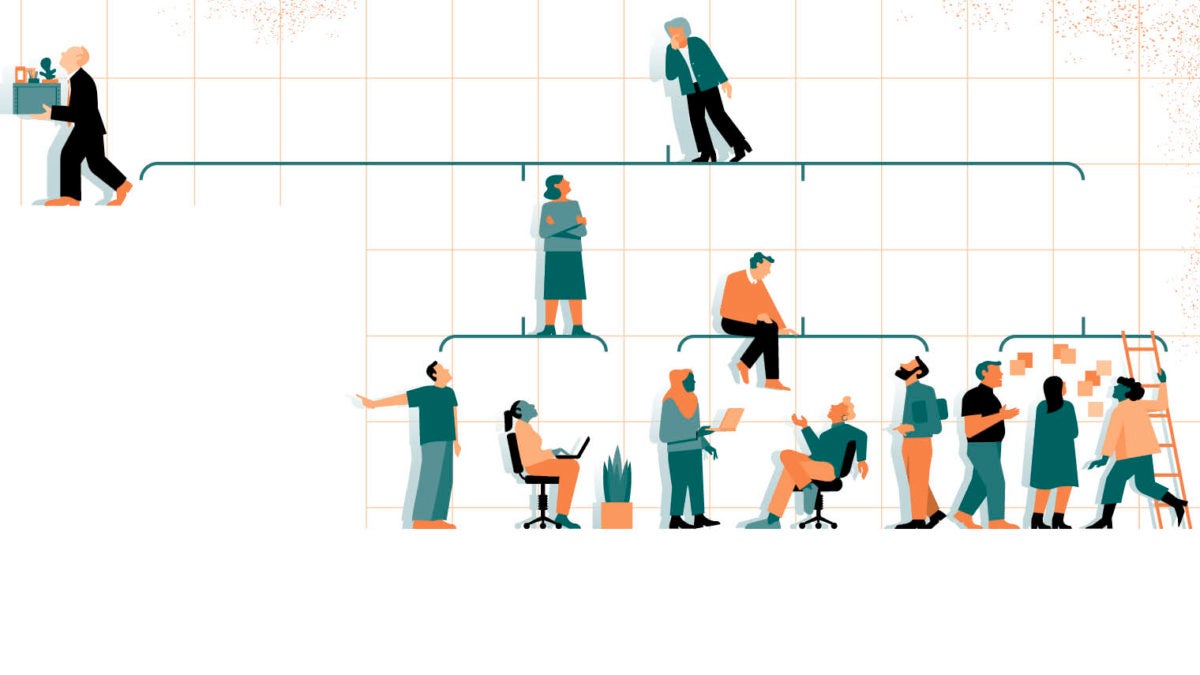How Middle Management Drives Productivity And Employee Engagement

Table of Contents
Fostering a Culture of Communication and Collaboration
Open and honest communication is the bedrock of a high-performing team. Middle managers play a pivotal role in establishing and maintaining these vital communication channels. Without clear and consistent communication, projects stall, misunderstandings arise, and employee morale suffers, directly impacting productivity.
Open Communication Strategies
Transparent communication fosters trust and reduces uncertainty. Middle managers should prioritize:
- Regular team meetings: Scheduled meetings provide opportunities for updates, discussions, and addressing concerns. These shouldn't be one-way broadcasts but interactive sessions encouraging participation.
- Effective feedback mechanisms: Creating systems for both upward and downward feedback is crucial. Employees need to feel comfortable sharing their input, while managers must provide constructive criticism and praise regularly.
- Utilizing various communication tools: Leveraging email, instant messaging, project management software, and even video conferencing ensures information reaches everyone effectively and efficiently.
- Promoting active listening and two-way dialogue: Truly hearing employee concerns and responding thoughtfully demonstrates respect and builds trust. This is a core element of effective communication and leadership.
Collaborative Teamwork
Middle managers should cultivate a collaborative environment where teamwork thrives. This boosts employee engagement and productivity by fostering a sense of shared purpose and mutual support.
- Encouraging team building activities: Activities outside of work can foster camaraderie and improve communication outside the formal work environment.
- Facilitating collaborative problem-solving: Middle managers should guide teams through challenges, empowering them to find solutions collectively rather than dictating answers.
- Using project management methodologies: Tools like Agile or Scrum can streamline workflows, improve transparency, and promote effective collaboration on projects.
- Recognizing and rewarding collaborative efforts: Acknowledging teamwork achievements reinforces the importance of collaboration and motivates employees.
Effective Delegation and Empowerment
Effective delegation isn't simply offloading tasks; it's about strategically distributing work to maximize team potential and develop individual skills. Empowerment goes hand-in-hand with delegation, allowing employees greater autonomy and fostering a sense of ownership.
Smart Delegation Techniques
Delegating effectively involves:
- Clearly defining roles and responsibilities: Ambiguity leads to confusion and missed deadlines. Ensure each team member understands their specific tasks and how they contribute to the bigger picture.
- Providing adequate training and support: Employees need the necessary skills and resources to succeed. Offering training and mentorship ensures they feel confident in their assigned tasks.
- Setting clear expectations and deadlines: Establish achievable goals with realistic timelines, ensuring transparency about project deliverables and timelines.
- Monitoring progress and offering constructive feedback: Regular check-ins allow for early problem detection and provide opportunities for guidance and support.
Empowering Employees
Empowered employees are more engaged, productive, and innovative. Middle managers can foster empowerment by:
- Giving employees autonomy in their work: Allowing employees to make decisions and take ownership of their tasks boosts morale and productivity.
- Providing opportunities for professional development: Investing in employee growth shows a commitment to their future and enhances their skills.
- Encouraging creativity and innovation: Creating a space for experimentation and new ideas fosters a dynamic and forward-thinking work environment.
- Trusting employees to make decisions: Showing faith in employees' abilities builds confidence and strengthens the team.
Providing Mentorship and Development
Investing in employee growth is a key aspect of effective middle management. Mentorship and robust performance management systems are essential for developing talent and improving team performance.
Mentoring and Coaching
Middle managers act as mentors and coaches, guiding employees toward professional and personal growth:
- Identifying employees' strengths and weaknesses: Through observation and feedback, managers can tailor development plans to individual needs.
- Providing personalized guidance and support: Mentorship involves active listening, offering advice, and helping employees navigate challenges.
- Facilitating career development opportunities: Supporting employees in pursuing promotions, training, or new roles shows commitment to their future.
- Creating a supportive and nurturing environment: A positive and encouraging workplace promotes learning and growth.
Performance Management and Feedback
Regular performance reviews and constructive feedback are vital for growth and improvement:
- Setting clear performance goals and expectations: Establish measurable objectives that align with overall team and organizational goals.
- Providing regular feedback and performance evaluations: Frequent feedback prevents surprises and allows for adjustments throughout the year. Annual reviews should be a culmination of ongoing feedback discussions.
- Using a balanced scorecard approach: Consider a holistic view of employee performance that encompasses both quantitative and qualitative aspects of their work.
- Identifying areas for improvement and providing support for development: Constructive criticism should be coupled with support and resources to help employees improve.
Driving Innovation and Problem-Solving
A strong middle management team fosters a culture of innovation and proactively addresses challenges. This dynamic environment boosts productivity and ensures the team remains adaptable and competitive.
Encouraging Creativity
Middle managers can foster innovation by:
- Creating a safe space for idea generation and experimentation: Encourage risk-taking and learning from failures.
- Implementing brainstorming sessions and idea generation workshops: Structured sessions stimulate creative thinking and collaboration.
- Providing resources and support for innovative projects: Allocate time, budget, and other necessary resources to support employee initiatives.
- Celebrating and rewarding innovative ideas: Acknowledge and reward employees who contribute creative solutions.
Proactive Problem-Solving
Effective problem-solving is essential for maintaining productivity. Middle managers should:
- Identifying potential problems early on: Regular monitoring of team performance and project progress helps identify potential issues before they escalate.
- Developing solutions collaboratively with the team: Involving the team in the problem-solving process fosters ownership and buy-in.
- Implementing effective problem-solving methodologies: Utilizing structured approaches to problem-solving ensures thorough analysis and efficient solutions.
- Monitoring and evaluating the effectiveness of solutions: Track the outcomes of implemented solutions to assess their impact and make necessary adjustments.
Conclusion
Effective middle management is not just a layer of hierarchy; it's the engine driving productivity and employee engagement. By fostering open communication, empowering employees, providing mentorship, and driving innovation, middle managers can transform their teams into high-performing units. Transform your middle management strategy today. Elevate your team’s productivity and engagement with these middle management tips. Learn more about maximizing employee engagement through effective middle management practices and see the difference it makes to your bottom line.

Featured Posts
-
 Did Sheffield United Dodge A Red Card Leeds United Clash Analysis
May 13, 2025
Did Sheffield United Dodge A Red Card Leeds United Clash Analysis
May 13, 2025 -
 Health Advisory Department Warns Of Rising Temperatures And Health Risks
May 13, 2025
Health Advisory Department Warns Of Rising Temperatures And Health Risks
May 13, 2025 -
 Nba Draft Lottery 2025 Predicting The No 1 Pick And Where To Watch
May 13, 2025
Nba Draft Lottery 2025 Predicting The No 1 Pick And Where To Watch
May 13, 2025 -
 Analyzing The Impact And Legacy Of The Da Vinci Code
May 13, 2025
Analyzing The Impact And Legacy Of The Da Vinci Code
May 13, 2025 -
 Eva Longoria At 50 Her Most Stunning Photos
May 13, 2025
Eva Longoria At 50 Her Most Stunning Photos
May 13, 2025
Latest Posts
-
 2025 Stadium Tour George Strait And Chris Stapletons Announced Dates
May 14, 2025
2025 Stadium Tour George Strait And Chris Stapletons Announced Dates
May 14, 2025 -
 George Strait And Chris Stapleton Announce Joint 2025 Stadium Tour
May 14, 2025
George Strait And Chris Stapleton Announce Joint 2025 Stadium Tour
May 14, 2025 -
 George Straits Dairy Queen Selfie Goes Viral Fans React To The Photo
May 14, 2025
George Straits Dairy Queen Selfie Goes Viral Fans React To The Photo
May 14, 2025 -
 Scotty Mc Creerys Child Shows Early Talent Singing George Strait Classics
May 14, 2025
Scotty Mc Creerys Child Shows Early Talent Singing George Strait Classics
May 14, 2025 -
 Country Music Legend George Strait Makes Unexpected Dairy Queen Stop
May 14, 2025
Country Music Legend George Strait Makes Unexpected Dairy Queen Stop
May 14, 2025
